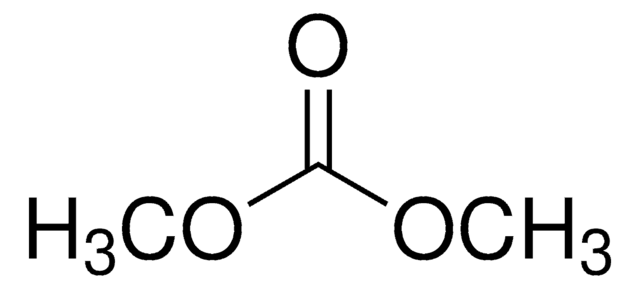439223
Diclorometano
suitable for HPLC, ≥99.9%, contains 40-150 ppm amylene as stabilizer
Sinónimos:
Cloruro de metileno
About This Item
Productos recomendados
grado
HPLC grade
Nivel de calidad
densidad de vapor
2.9 (vs air)
presión de vapor
24.45 psi ( 55 °C)
6.83 psi ( 20 °C)
Ensayo
≥99.9%
Formulario
liquid
temp. de autoignición
1223 °F
contiene
40-150 ppm amylene as stabilizer
lim. expl.
22 %
técnicas
HPLC: suitable
impurezas
Free halogens, passes test
≤0.0003 meq/g Titr. acid
≤0.02% water
residuo de evap.
<0.0003%
color
APHA: ≤10
clear
índice de refracción
n20/D 1.424 (lit.)
bp
39.8-40 °C (lit.)
mp
−95 °C (lit.)
densidad
1.325 g/mL at 25 °C (lit.)
λ
H2O reference
Absorción UV
λ: 235 nm Amax: 1.00
λ: 240 nm Amax: 0.20
λ: 250 nm Amax: 0.05
λ: 260 nm Amax: 0.02
λ: 340-400 nm Amax: 0.01
idoneidad
passes test for HPLC
cadena SMILES
ClCCl
InChI
1S/CH2Cl2/c2-1-3/h1H2
Clave InChI
YMWUJEATGCHHMB-UHFFFAOYSA-N
¿Está buscando productos similares? Visita Guía de comparación de productos
Descripción general
Aplicación
- To compose ultrasonic baths for cleaning and protection of aluminum coating over atactic-PMMA (poly(methyl methacrylate)) for dielectric studies.
- Preparation of AMBF3 (ammoniomethyltrifluoroborate)-conjugated biomolecules.
- Sample preparation for GC-MS (Gas Chromatography-Mass Spectrometry) analysis.
- Preparation of ammonium acetate solvent mixture in combination with isopropanol, acetonitrile and water for mass spectral analysis of neutral lipids.
- Quantification of glutathione (GSH) and glutathione disulfide (GSSG) in biological samples by HPLC and spectrophotometry.
- As an extractant for 2,2-dithioethyl-4-(2′-pyridyl)-4-butyro-γ-lactone.
Envase
As a global leader in lab reagents, we are constantly looking for new ways to optimize the safety of our products. The newly developed 4L solvent bottle design features advanced sealing technology that eliminates leaks to make the handling of solvents safer and more convenient than ever before.
See all the new features here!
Nota de preparación
Palabra de señalización
Warning
Frases de peligro
Consejos de prudencia
Clasificaciones de peligro
Carc. 2 - Eye Irrit. 2 - Skin Irrit. 2 - STOT SE 3
Órganos de actuación
Central nervous system
Código de clase de almacenamiento
6.1D - Non-combustible acute toxic Cat.3 / toxic hazardous materials or hazardous materials causing chronic effects
Clase de riesgo para el agua (WGK)
WGK 2
Punto de inflamabilidad (°F)
does not flash
Punto de inflamabilidad (°C)
does not flash
Equipo de protección personal
Eyeshields, Faceshields, Gloves
Listados normativos
Los listados normativos se proporcionan para los productos químicos principalmente. Para los productos no químicos sólo se puede proporcionar información limitada. Si no hay ninguna entrada, significa que ninguno de los componentes está en la lista. Es obligación del usuario garantizar el uso seguro y legal del producto.
EU REACH Annex XVII (Restriction List)
Elija entre una de las versiones más recientes:
¿Ya tiene este producto?
Encuentre la documentación para los productos que ha comprado recientemente en la Biblioteca de documentos.
Nuestro equipo de científicos tiene experiencia en todas las áreas de investigación: Ciencias de la vida, Ciencia de los materiales, Síntesis química, Cromatografía, Analítica y muchas otras.
Póngase en contacto con el Servicio técnico





